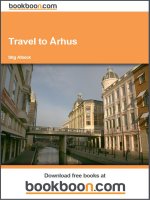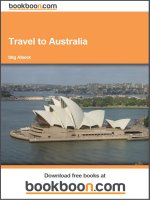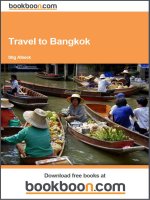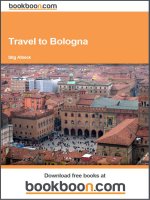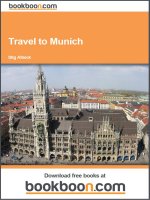Travel to Sofia pot
Bạn đang xem bản rút gọn của tài liệu. Xem và tải ngay bản đầy đủ của tài liệu tại đây (4.97 MB, 43 trang )
Download free ebooks at bookboon.com
Download free ebooks at bookboon.com
Sofia
© 2010 Stig Albeck & Ventus Publishing ApS
Translation:
All rights and copyright relating to the content of this
book are the property of Ventus Publishing ApS, and/or its
suppliers. Content from this book, may not be reproduced
in any shape or form without prior written permission from
Ventus Publishing ApS.
Quoting this book is allowed when clear references are made,
in relation to reviews are allowed.
ISBN 978-87-7061-477-1
2nd edition
Pictures and illustrations in this book are reproduced according
to agreement with the following copyright owners
Stig Albeck
The stated prices and opening hours are indicative and may
have be subject to change after this book was published.
Download free ebooks at bookboon.com
Sofi a/Coфия
4
Kapiteloverskrift ONLIBRI
Download free ebooks at bookboon.com
Sofi a/Coфия
5
A Visit to Sofi a/Coфия
A Visit to Sofia/
ǿȜȢȖȭ
www.sofia.bg
www.bulgariatravel.org
The Bulgarian capital of Sofia is an ancient city
that, since the severance from the Ottoman
Empire in 1878, has developed from provincial
town to cosmopolitan city with a pleasant
atmosphere among the many sights, gardens and
parks, and fashionable shopping centres
welcoming visitors.
Sofia’s countless beautiful buildings and structures
from centuries past stand side by side with ancient
churches and various buildings from not least the
Ottoman era. Along with the imposing style of
building of the Bulgarian Communist era, this adds
an interesting architectural variety to Sofia’s
townscape.
The surroundings of Sofia are characterized by
beautiful nature and relics of ancient culture. The
Vitosha Mountains are located right outside the
city boundaries of Sofia and they, thus, offer a
possibility of experiencing near-wilderness
surroundings just a short trip from the big city.
The Rila Monastery and the second-largest
Bulgarian city, Plovdiv, are both places that
demonstrate the culture and rich history of the
region.
Have a great trip!
Download free ebooks at bookboon.com
Sofi a/Coфия
6
Historical Overview
Historical Overview
Sofia is located in western Bulgaria’s fertile flat
country and the agricultural potentialities have
attracted settlers and generally influenced the area
for thousands of years.
The first permanent settlement is believed to have
been by the Thracian tribe Serdi that founded
Serdica. Remains of Serdica have been discovered
in what is now the centre of Sofia.
Despite many attacks, the Greek Thracians
managed to keep Serdica through centuries, at
least until the Romans settled here around AD 100.
Serdica became a fortified principal town in the
province of Dacia.
As was the case when Philip II of Macedon
destroyed Serdica in 339 BC, the town was
seriously ravaged after the attack of the Huns in
the 400s. However, 200 years would pass before
an actual reconstruction took place. This happened
during Byzantium’s Emperor Justinian’s rule in the
600s.
In the end of the 600s, Bulgarian khan Asparuh
fought Byzantium and, following a victory in 681,
the first Bulgarian kingdom was established. Pliska
was made capital and the newly established
territory covered parts of present Bulgaria.
During the rule of khan Krum, King of Bulgaria in
803-814, great battles were fought against the
Byzantines and, in 809, Serdica was conquered.
The town now became known as Sredets and part
of the Bulgarian kingdom. Until 1018, Bulgarians
and armies of the Byzantine Emperor fought
continuously. In 1018, Emperor Basil, also known
as the Killer of Bulgarians, conquered the
Bulgarian kingdom and, thus, also Sredets which
now changed its name to the Byzantine Triaditsa.
In 1186, the second Bulgarian kingdom was
established when a rebellion arose against
Byzantium in Veliko Tarnovo. Veliko Tarnovo
now became the capital of the new kingdom. The
name Sofia first appeared in 1382 in a document
from Tsar Shishman. The name of the city refers
to the Hagia Sofia Church that can still be seen in
Sofia today.
In 1396, Bulgaria was conquered by Turks from
Istanbul and this was the beginning of almost 500
years under foreign rule. The Turks attempted to
introduce their culture and traditions to the newly
conquered area but constantly there was a
Bulgarian resistance to the foreign power, not least
from the monasteries south of Sofia.
During the Turkish rule, the country developed
financially; however, Sofia did not undergo the
rapid growth that other later big cities in Europe
experienced. Thus, until Bulgaria’s emancipation,
Sofia remained quite a small city.
In the middle of the 1800s, the Bulgarian national
resistance to the Ottomans had grown, which
manifested itself in actual fighting. Among the
rebels gathering in monasteries in the mountains
were Vasil Levski and Hristo Botev; two great
heroes of the war of independence.
Following unsuccessful attacks in 1876, forces from
nearby Russia arrived in 1878. In company with the
Bulgarians, the Russians fought against the
Ottomans, who had to withdraw from Bulgaria. It
was this year that Bulgaria became independent.
The following year, Sofia, which at the time had a
population of 18,000 people, was made capital of
Bulgaria. This decision was the beginning of Sofia’s
development into the megapolis that it is today.
Download free ebooks at bookboon.com
Sofi a/Coфия
7
Historical Overview
The German prince, Alexander, was elected King
of Bulgaria in Sofia. By early industrialization, the
city flourished. The following decades, many
leadership replacements took place in Sofia.
Alexander abdicated and Prince Ferdinand was
made King of Bulgaria and from 1895-1918 self-
proclaimed Tsar. Hereafter, Boris III attained
power. From 1923, the country was governed by
the nationalist military rule. That same year, a
Communist coup attempt lead by Georgi
Dimitrov failed and Dimitrov had to flee.
The 1930s were affected by industrialization even
though agriculture still was of great importance to
Bulgarian society. During World War II, Sofia was
destroyed by bombardments. This created an even
more urgent housing shortage than previously.
Georgi Dimitrov returned to Sofia as the new
leader of the new Communist democratic republic.
At the same time as Bulgaria became one of
Eastern Europe’s great agricultural countries,
Bulgaria also developed industrially; especially
around Sofia where many new city quarters were
built in the decades following the war.
In 1990, there was a change of the Bulgarian
political system. Today, visitors can expect a green
and charming capital where attractions and sights
are within walking distance.
Download free ebooks at bookboon.com
Sofi a/Coфия
8
Tour 1. Sofi a/Coфия
Tour 1: Sofia/ǿȜȢȖȭ
1. Sofia Synagogue/ǿȜȢȖȗȟȘȎ
ȟȖțȎȑȜȑȎ
ul. Ekzarh Josif 16/ȀǸ. ǒǷǴǭǽȂ ǖǻǾǵȁ 16
www.sofiasynagogue.com
Metro: Serdika/ǞDzǽDZǵǷǭ
The Sofia Synagogue is designed by Austrian
Friedrich Grünanger in 1909. The synagogue is a
symbol of the Jews’ part in the establishment of the
capital of Sofia. That is, the Jews played a quite
significant part in 1878 when the Turkish Ottomans
could have destroyed much more of the city during
their withdrawal than was actually the case.
At the time of its construction, almost every fifth
inhabitant in Sofia was Jewish and the Sofia
Synagogue is the largest Sephardic synagogue in
Europe. Inside, one can view an impressive brass
chandelier weighing 2.2 tons hanging from the
dome, among other things.
2. Central Sofia Market
Hall/ȄȓțȠȞȎșțȖ ȟȜȢȖȗȟȘȖ ȣȎșȖ
Bul. Maria Luiza 28/ǎȀǸ. ǙǭǽǵȌ ǘȀǵǴǭ Ȳ 28
Metro: Serdika/ǞDzǽDZǵǷǭ
The Central Sofia Market Hall, also known simply
as Halite/ǢǭǸǵǿDz is Sofia’s great covered market.
The building was built in 1909 and inaugurated in
1911. Bulgarian Naum Torbov is the architect and
the neo-renaissance halls are considered his best
work. Today, the halls are restored and appear as a
combination of market and shopping mall where
the old setting has been preserved.
Download free ebooks at bookboon.com
Please click the advert
Sofi a/Coфия
9
Tour 1. Sofi a/Coфия
3. Banya Bashi Mosque/DzȔȎȚȖȭ
ǯȎțȭ ǯȎȦȖ
Maria Luiza Boulevard /
ǎȀǸȀǯǭǽDZ ǙǭǽǵȌ ǘȀǵǴǭ
Metro: Serdika/ǞDzǽDZǵǷǭ
The great Banya Bashi Mosque is built in 1576 by
Ottoman master builder Hadzhi Mimar Sonah. It
is built in a stately style of sultans with a large
dome and minaret.
The name Banya Bashi means ‘many baths’ and is
derived from the neighbouring buildings which are
the city’s historical natural thermal spas. The
mosque is still functioning.
Download free ebooks at bookboon.com
Sofi a/Coфия
10
Tour 1. Sofi a/Coфия
4. Sofia Public Mineral
Baths/ȄȓțȠȞȎșțȎ ȚȖțȓȞȎșțȎ ȏȎțȭ
ul. Triaditsa/ȀǸ. ǟǽǵǭDZǵȃǭ
Metro: Serdika/ǞDzǽDZǵǷǭ
Sofia is blessed with several curative springs with
water temperatures of about 50 °C. Sofia’s Public
Mineral Baths are built in an impressive Oriental
style and it is definitely Sofia’s most beautiful
historical bathing spa. It was built in 1911-1913 as
‘The Turkish Bath’ and continued to work as
public baths until 1986.
5. Largo/ǹȎȞȑȜ
pl. Nezavisimost/ǼǸ. ǚDzǴǭǯǵǾǵǹǻǾǿ
www.parliament.bg
www.government.bg
www.president.bg
www.sheraton.com
www.tzum.bg
Metro: Serdika/ǞDzǽDZǵǷǭ
Largo is the name of the centrally located building
complex that functioned as headquarters of the
former Bulgarian Communist Party. Also known
as the Party House/ǎǵǯȅǭ ǾǰǽǭDZǭ Ǻǭ
ǷǻǹȀǺǵǾǿǵȄDzǾǷǭǿǭ ǼǭǽǿǵȌ, it was built in the
1950s. A stately and grandiose style characterizes
the building complex; this is due to the fact that
the buildings were meant to represent the
capabilities of the political system after World War
II. Certainly, it is too one of the most beautiful
examples of Communist architecture in Eastern
Europe outside the former Soviet Union.
In 1951, it was decided to build the Largo and, the
following year, the site was cleared of buildings
damaged during World War II. The building of the
central Party House was completed in 1955; at that
time, graced with a red star on top. In 1965, the
ministerial building south of the Party House was
completed and, the following year, the department
store TZUM/ǣǠǙ was built north of the Party
House.
Originally, there was a statue of Lenin situated in
the open space between the Largo buildings,
known as the Independence Square (pl.
Nezavisimost); however, since 2000, a statue of St
Sofia has embellished the square.
Today, the three Largo buildings are in use for
different purposes. The Party House is now
employed as offices for the Bulgarian National
Assembly, ǚǭǽǻDZǺǻ ǾȇǮǽǭǺǵDz. The building located
south of the Party House houses both the President
of Bulgaria as well as an international hotel. The
department store TZUM is still located in the
northern building, which also houses the Council of
Ministers of Bulgaria, ǙǵǺǵǾǿDzǽǾǷǵȌǿ ǾȇǯDzǿ.
Download free ebooks at bookboon.com
Sofi a/Coфия
11
Tour 1. Sofi a/Coфия
6. Church of St George/ȄȨȞȘȐȎ
ǿȐȓȠȖ DZȓȜȞȑȖ
Dondukov Boulevard 2/ ǎȀǸ. ǑǻǺDZȀǷǻǯ Ȳ 2
Metro: Serdika/ǞDzǽDZǵǷǭ
This church is the oldest preserved building in
Sofia; it is built in the shape of a rotunda by the
Romans in the 300s. It was not until the Middle
Ages that the building was made a church. Inside
the Church of St George, there are a number of
frescos painted during several centuries; some are
painted as early as the 900s. Next to the church,
remains of the Roman town Serdica can be seen.
Today, the location houses a museum. The church
can be somewhat difficult to find since it is
situated in the courtyard of a block.
7. Church of St Petka
Samardshiiska/ȄȨȞȘȐȎ ǿȐȓȠȎ ǽȓȠȘȎ
ǿȎȚȎȞȒȔȖȗȟȘȎ
pl. Nezavisimost/ǼǸ. ǚDzǴǭǯǵǾǵǹǻǾǿ
Metro: Serdika/ǞDzǽDZǵǷǭ
This little church is located in the middle of Sofia’s
busy traffic. One arrives at the church by a
pedestrian subway, which means that it is actually
easier than it looks to get to it.
The church is named after Bulgarian saint St Petka.
It is erected on the spot where a religious building
was located as early as back in the Roman Period.
The present church contains excellent frescos
from several centuries of the Middle Ages.
Download free ebooks at bookboon.com
Sofi a/Coфия
12
Tour 1. Sofi a/Coфия
8. Church of Sveta Nedelja/ȄȨȞȘȐȎ
ǿȐȓȠȎ ǻȓȒȓșȭ
Pl. Sveta Nedelja/ǜǸ. ǞǯDzǿǭ ǚDzDZDzǸȌ
Metro: Serdika/ǞDzǽDZǵǷǭ
The Church of Sveta Nedelja is built in the old
town centre of Sofia when the city was known as
Serdica. In the Roman Period, a large structure,
measuring 100x50 metres in base, was situated
here; this building is believed to have been a civil
administration building.
Down through the ages, several churches have
been located on this very spot. The present, the
Church of Sveta Nedelja, is built in 1856-1863.
Previously, the church was known as ‘The Church
of the Blessed King’, named after Serbian King
Stefan Uroš II Milutin ruling in the 1300s. His
relics have been stored here in a wooden chest
since the 1700s.
Today, the church is Sofia’s second most important
religious location after the Aleksander Nevski
Cathedral. Among the Bulgarians buried here is
Joseph I, Bulgarian church leader in 1877-1915.
9. Vitosha Boulevard /ǯȡșȓȐȎȞȒ
ǰȖȠȜȦȎ
Vitosha Boulevard/ǎȀǸDzǯǭǽDZ Ǐǵǿǻȅǭ
Metro: Serdika/ǞDzǽDZǵǷǭ
The central street, Vitosha Boulevard, runs south
from Sofia’s town centre towards the silhouette of
the Vitosha Mountains rising in the air, 7
kilometres outside the capital. The street functions
as one of the main streets in Sofia with lots of
cafés and shops; Vitosha Boulevard is actually one
of the most expensive shopping streets in Europe
with many famous brands.
Until the beginning of the 1900s, all but merely
smaller buildings could be found on this long-
stretching street but, in the time between World
War I and II, several great, beautiful buildings
arose side by side.
10. Sofia Court House/ǿȨȒȓȏțȎ
ȝȎșȎȠȎ
Vitosha Boulevard 2/ǎȀǸDzǯǭǽDZ Ǐǵǿǻȅǭ 2
www.vks.bg
Metro: Serdika/ǞDzǽDZǵǷǭ
The Sofia Court House is built in an imposing
neo-classical style and is one of the more
grandiose structures along the magnificent Vitosha
Boulevard. The courthouse was built in 1929-1940.
Download free ebooks at bookboon.com
Please click the advert
Sofi a/Coфия
13
Tour 1. Sofi a/Coфия
© Deloitte & Touche LLP and affiliated entities.
360°
thinking
.
Discover the truth at www.deloitte.ca/careers
© Deloitte & Touche LLP and affiliated entities.
360°
thinking
.
Discover the truth at www.deloitte.ca/careers
© Deloitte & Touche LLP and affiliated entities.
360°
thinking
.
Discover the truth at www.deloitte.ca/careers
© Deloitte & Touche LLP and affiliated entities.
360°
thinking
.
Discover the truth at www.deloitte.ca/careers
Download free ebooks at bookboon.com
Sofi a/Coфия
14
Tour 2. Sofi a/Coфия
Tour 2: Sofia/ǿȜȢȖȭ
11. National Archaeological
Museum/ǻȎȤȖȜțȎșȓț
ǮȞȣȓȜșȜȑȖȥȓȟȘȖ Țȡȕȓȗ
ul. Saborna 2/ȀǸ. ǞȇǮǻǽǺǭ Ȳ 2
Metro: Serdika/ǞDzǽDZǵǷǭ
The National Archaeological Museum contains
countless finds, not least from Bulgaria’s Thracian
and Roman past. Among the many objects are
bronzes of the 700s, mosaics of the 500-600s as
well as a Greek tombstone of the 500s from the
ancient town of Apollonia; now
Sozopol/ǞǻǴǻǼǻǸ.
The museum occupies the building of the former
Grand Mosque, Bujuk Dzjamija/ǎȀȋǷ DZdzǭǹǵȌ;
the largest and oldest of the mosques built during
Ottoman rule. The building started around the
year 1474 under Sultan Mehmed II.
Download free ebooks at bookboon.com
Sofi a/Coфия
15
Tour 2. Sofi a/Coфия
12. Bulgarian National
Bank/ǯȨșȑȎȞȟȘȎ țȎȞȜȒțȎ ȏȎțȘȎ
Prince Alexander of Battenberg
Square/ǜǸǻȆǭDZ ǗǺȌǴ ǍǸDzǷǾǭǺDZȇǽ
ǎǭǿDzǺǮDzǽǰ
www.bnb.bg
Metro: Serdika/ǞDzǽDZǵǷǭ
The building of the Bulgarian National Bank in
Sofia houses a museum depicting the monetary
history of Bulgaria and that of the bank itself. The
museum opened in 1999 in connection with the
bank’s 120th anniversary.
13. Prince Alexander of Battenberg
Square/ǽșȜȧȎȒ Ǹțȭȕ ǮșȓȘȟȎțȒȨȞ
ǯȎȠȓțȏȓȞȑ
Prince Alexander of Battenberg
Square/ǜǸǻȆǭDZ ǗǺȌǴ ǍǸDzǷǾǭǺDZȇǽ
ǎǭǿDzǺǮDzǽǰ
Metro: Serdika/ǞDzǽDZǵǷǭ
This square is the largest in Sofia and several large
buildings and institutions surround it. The square
is named after Alexander Joseph of Battenberg,
who was the first prince of modern Bulgaria. He
reigned from 1879-1889.
During Bulgaria’s Communist era lasting from
1944-1989, the square was named after the special
day of September 9th; the day of the Communist
takeover. Since the death of the head of state,
Georgi Dimitrov, in 1949, his embalmed body was
kept in a mausoleum here, at least until the year of
1999 when the mausoleum was pulled down.
14. National Art Gallery/ǻȎȤȖȜțȎșțȎ
ȣȡȒȜȔȓȟȠȐȓțȎ ȑȎșȓȞȖȭ
Prins Alexander Battenberg-pladsen/ǜǸǻȆǭDZ
ǗǺȌǴ ǍǸDzǷǾǭǺDZȇǽ ǎǭǿDzǺǮDzǽǰ
Metro: Serdika/ǞDzǽDZǵǷǭ
The Sofia National Art Gallery is situated in
Bulgaria’s former royal palace, which was built in
1887. The museum displays Bulgarian works of art,
emphasizing the period following the liberation of
Bulgaria in 1878.
The historical royal palace, also an attraction in
itself, constitutes the perfect setting for the display
of interesting works of art.
15. National Ethnographical
Museum/dzȠțȜȑȞȎȢȟȘȖ Țȡȕȓȗ
ul. Moskovska 6A/ȀǸ. ǙǻǾǷǻǯǾǷǭ Ȳ 6Ǎ
Metro: Serdika/ǞDzǽDZǵǷǭ
Like the National Art Gallery, the Sofia National
Ethnographical Museum is housed in the former
Download free ebooks at bookboon.com
Sofi a/Coфия
16
Tour 2. Sofi a/Coфия
royal palace. Here, one can view an interesting
collection of Bulgarian arts and crafts f the latest
centuries.
16. National Museum of Natural
History/ǻȎȤȖȜțȎșȓț
ȝȞȖȞȜȒȜțȎȡȥȓț Țȡȕȓȗ
Bul. Zar Osvboditel/ǎȀǸ. ǣǭǽ ǛǾǯǻǮǻDZǵǿDzǸ
www.nmnh.bas.bg
Metro: Serdika/ǞDzǽDZǵǷǭ
The Bulgarian National Museum of Natural
History is one of the largest of its kind in the
Balkans. It was founded in 1889 and holds a large
collection of animal and mineral species.
17. Russian Church of Sofia/Church
of St Nicholas the Miracle-
Maker/ǾȡȟȘȎȠȎ ȤȨȞȘȐȎ ǿȐȓȠȖ
ǻȖȘȜșȎȗ ȅȡȒȜȠȐȜȞȓȤ
Bul. Zar Osvboditel 3/ǎȀǸ. ǣǭǽ
ǛǾǯǻǮǻDZǵǿDzǸ Ȳ 3
Metro: Serdika/ǞDzǽDZǵǷǭ
The Church of St Nicholas the Miracle-Maker is
designed in Russian style and built in 1907-1914
on the site where a mosque until the year of 1882
was located. It was built as an official Russian
church serving the Russian community and
Russia’s embassy in Sofia.
In keeping with tradition for such official Russian
churches, the church is named after Russian ruler at
the time of construction; Tsar Nicholas II of Russia.
The beautiful church is inspired by Muscovite
Russian churches of the 1600s. It has golden
Download free ebooks at bookboon.com
Please click the advert
Sofi a/Coфия
17
Tour 2. Sofi a/Coфия
onion-shaped copulas and a typical motley exterior.
The fact that the church is located in a small
garden makes the attraction even more appealing
and worth visiting.
18. Central Military Club/ȄȓțȠȞȎșȓț
ȐȜȓțȓț Șșȡȏ
Bul. Zar Osvboditel 7/ǎȀǸ. ǣǭǽ
ǛǾǯǻǮǻDZǵǿDzǸ 7
Metro: Serdika/ǞDzǽDZǵǷǭ
The Central Military Club is a multi-purpose
cultural scene administered by the Bulgarian Army.
Among other things, the building holds a concert
hall as well as several exhibition halls.
The edifice was built in 1895-1907 in a neo-
renaissance style, designed by Czech architect
Antonín Koláő.
Increase your impact with MSM Executive Education
For more information, visit www.msm.nl or contact us at +31 43 38 70 808
or via
the globally networked management school
For more information, visit www.msm.nl or contact us at +31 43 38 70 808 or via
For almost 60 years Maastricht School of Management has been enhancing the management capacity
of professionals and organizations around the world through state-of-the-art management education.
Our broad range of Open Enrollment Executive Programs offers you a unique interactive, stimulating and
multicultural learning experience.
Be prepared for tomorrow’s management challenges and apply today.
Executive Education-170x115-B2.indd 1 18-08-11 15:13
Download free ebooks at bookboon.com
Sofi a/Coфия
18
Tour 2. Sofi a/Coфия
19. Ivan Vazov National
Theatre/ǻȎȞȜȒȓț ȀȓȎȠȨȞ ǶȐȎț ǰȎȕȜȐ
pl. Djakon Ignatij 5/ǼǸ. ǑȌǷǻǺ ǕǰǺǭǿǵǶ Ȳ 5
www.nationaltheatre.bg
Metro: Serdika/ǞDzǽDZǵǷǭ
Beautifully located facing the City Garden lies the
elegant Ivan Vazov National Theatre. The theatre
was founded in 1904 and the neo-classical building
completed in 1906. Today, it is one of the most
famous architectural landmarks of Sofia.
In 1923, the theatre was extensively damaged by a
fire and not until the year of 1929 was the building
reconstructed by German architect Martin Dülfer.
The theatre is named after the author Ivan Vazov,
who laid the foundations of modern Bulgarian
literature. The Ivan Vazov National Theatre holds
many stages and the largest stage seats about 750
people.
20. Sofia Art Gallery/DZȞȎȒȟȘȎ
ȑȎșȓȞȖȭ
ul. Gen Gurko 1/ȀǸ. ǐDzǺ ǐȀǽǷǻ Ȳ 1
Metro: Serdika/ǞDzǽDZǵǷǭ
Sofia Art Gallery is located in the central City
Garden. The gallery has alternating exhibitions of
different art forms. Holding thousands of works,
the museum has one of the most abundant and
rich collections in Bulgaria, and it is, normally,
parts of this collection that are displayed.
With its many fountains and flower gardens, the
City Garden is the most beautiful garden in the
centre of Sofia. The park oozes tranquillity and
many locals come here to play chess, among other
pastimes.
21. Ivan Vazov Museum/Țȡȕȓȗ țȎ
ǶȐȎț ǰȎȕȜȐ
ul. Ivan Vazov/ȀǸ. ǕǯǭǺ ǏǭǴǻǯ
www.slovo.bg/vazovmuseum
Metro: Kl. Okhridski/ǗǸ.ǛȂǽǵDZǾǷǵ
(future station)
Ivan Vazov is one of the most noted and treasured
Bulgarian authors. Especially, his short story Pod
igoto/ǜǻDZ ǵǰǻǿǻ, dealing with life around the
time of the revolt against the Turkish Ottoman
Empire, is widely famous. The museum is situated
on the very location where Vazov lived from 1895
to the end of his life. The interior has remained
practically untouched since that time.
Download free ebooks at bookboon.com
Sofi a/Coфия
19
Tour 2. Sofi a/Coфия
Download free ebooks at bookboon.com
Please click the advert
Sofi a/Coфия
20
Tour 3. Sofi a/Coфия
Tour 3: Sofia/ǿȜȢȖȭ
22. Monument to the Tsar
Liberator/ǽȎȚȓȠțȖȘ țȎ ȄȎȞ
ǼȟȐȜȏȜȒȖȠȓș
pl. Narodno Sabranie/ǼǸ. ǚǭǽǻDZǺǻ ǾȇǮǽǭǺǵDz
Metro: Kl. Okhridski/ǗǸ.ǛȂǽǵDZǾǷǵ
(future station)
The equestrian monument of Russian Emperor
Alexander II is situated on the square in front of
the National Assembly of Bulgaria. The
foundation stone was laid in 1901, in 1903, the
monument was completed, and, finally, in 1907, it
was officially inaugurated.
The monument was erected in honour of the tsar
who liberated Bulgaria by defeating the Turkish
Ottomans during the Russo-Turkish War of 1877-
1878. Following this victory, Bulgaria could finally
re-establish itself as an independent state.
The statue is partly made of black granite from the
Vitosha Mountains located just south of Sofia.
Also, bronze parts adorn the monument; the
bronze is from Rumania in memory and honour of
the many Rumanian soldiers who died during the
war. The bas-relief depicts a group of Bulgarian
and Russian soldiers under the command of Greek
Goddess of Victory, Nike, her sword raised high.
Get “Bookboon’s Free Media Advice”
See the light!
The sooner you realize we are right,
the sooner your life will get better!
A bit over the top? Yes we know!
We are just that sure that we can make your
media activities more effective.
Download free ebooks at bookboon.com
Sofi a/Coфия
21
Tour 3. Sofi a/Coфия
23. National Assembly of
Bulgaria/ǻȎȞȜȒțȜ ȟȨȏȞȎțȖȓ
pl. Narodno Sabranie 2/
ǼǸ. ǚǭǽǻDZǺǻ ǾȇǮǽǭǺǵDz 2
www.parliament.bg
Metro: Kl. Okhridski/ǗǸ.ǛȂǽǵDZǾǷǵ
(future station)
The National Assembly is the Bulgarian parliament.
The history of the parliament dates as far back as
1879. The current composition is formed on the
basis of Bulgaria’s constitution from 1991. The
parliament building is constructed in neo-
renaissance style in the years 1884-1886, designed
by Bulgarian architect Konstantin Jovanoviý.
24. Bulgarian Academy of
Sciences/ǯȨșȑȎȞȟȘȎ ȎȘȎȒȓȚȖȭ țȎ
țȎȡȘȖȠȓ
ul. 15 novembri 1/ȀǸ. 15 ǺǻDzǹǯǽǵ Ȳ1
www.bas.bg
Metro: Kl. Okhridski/ǗǸ.ǛȂǽǵDZǾǷǵ
(future station)
The Bulgarian Academy of Sciences is founded in
1869 and is an institute of education primarily
specializing in engineering, natural, and
mathematical sciences.
The academy was founded as a literary Bulgarian
society in Rumania since Bulgaria, at that time, was
under Ottoman occupation. Immediately
following Bulgaria’s emancipation in 1878, the seat
of the society was moved to Sofia from Rumanian
town BrĈila and, since 1893, the society has been
housed in the present building, erected for this
exact purpose. Since then, the academy has
developed considerably.
Download free ebooks at bookboon.com
Sofi a/Coфия
22
Tour 3. Sofi a/Coфия
25. Aleksander Nevski
Cathedral/ȃȞȎȚ-ȝȎȚȓȠțȖȘ ǿȐȓȠȖ
ǮșȓȘȟȎțȒȨȞ ǻȓȐȟȘȖ
Pl. Aleksander Nevski/
ǜǸ. ǍǸDzǷǾǭǺDZȇǽ ǚDzǯǾǷǵ
Metro: Kl. Okhridski/ǗǸ.ǛȂǽǵDZǾǷǵ
(future station)
Sofia’s beautiful orthodox cathedral, built in neo-
byzantine style in 1912, commemorates the
Russian casualties of the Russo-Turkish War of
1877-1878. In this way, it also stands in memory of
the Bulgarian liberation that was a direct result of
the Russian victory.
The church’s status as cathedral implies that it
serves as headquarters for the patriarch of Bulgaria.
It is named after the powerful Grand Duke of
Novgorod and Vladimir, who was very talented
and victorious regarding both politics and military
encounters; he is considered one of the most
noted and important individuals in Russian history.
The Aleksander Nevski Cathedral is built over a
period of 30 years, and workers and artists from
six different countries have, among other works,
crafted very beautiful icons and frescoes. The
interior of the church is decorated with marble,
Egyptian alabaster, and Brazilian onyx and gold,
among other luxurious materials. Together with
the most abundant collection of icons in Bulgaria,
these materials all appear to advantage.
The dimensions of the church are quite sizeable.
The central gold-plated dome is 45 metres high
and the bell tower reaches 50.5 metres. The church
can seat 5,000 people. The foundation stone was
laid in 1882 though the actual construction took
place in the years 1904-1912.
26. National Art Gallery for Foreign
Art/ǻȎȤȖȜțȎșțȎ ȑȎșȓȞȖȭ ȕȎ
ȥȡȔȒȓȟȠȞȎțțȜ ȖȕȘȡȟȠȐȜ
Pl. Alexander Nevski 1/ ǜǸ. ǍǸDzǷǾǭǺDZȇǽ
ǚDzǯǾǷǵ Ȳ 1
www.foreignartmuseum.bg
Metro: Kl. Okhridski/ǗǸ.ǛȂǽǵDZǾǷǵ
(future station)
The National Art Gallery for Foreign Art opened
in 1985 and, as its name implies, the gallery
displays non-Bulgarian works of art. Different
works of art from mainly Europe, Africa, and Asia
can be experienced here; for instance, the beautiful
Japanese collection is worth seeing.
Download free ebooks at bookboon.com
Please click the advert
Sofi a/Coфия
23
Tour 3. Sofi a/Coфия
The museum is built in 1883-1884 as the head
office for the royal printing house and it was
designed by Austrian Schwanberg.
27. The Holy Synod/ǿȖțȜȒțȎ ȝȎșȎȠȎ
Pl. Alexander Nevski/
ǜǸ. ǍǸDzǷǾǭǺDZȇǽ ǚDzǯǾǷǵ
Metro: Kl. Okhridski/ǗǸ.ǛȂǽǵDZǾǷǵ
(future station)
This building, located by the Aleksander Nevski
square, houses Bulgaria’s church administration as
well as the offices of the patriarch, the religious
head of the country. On the outside of the
building, interesting mosaics are worth noticing.
GO T -THE-ENER GY -TO-LEAD.COM
We believe that energy suppliers should be renewable, too. We are therefore looking for enthusiastic
new colleagues with plenty of ideas who want to join RWE in changing the world. Visit us online to find
out what we are offering and how we are working together to ensure the energy of the future.
Download free ebooks at bookboon.com
Sofi a/Coфия
24
Tour 3. Sofi a/Coфия
28. Hagia Sofia Church/ȄȨȞȘȐȎ
ǿȐȓȠȎ ǿȜȢȖȭ
ul. Paris 2/ȀǸ. ǜǭǽǵdz Ȳ 2
Metro: Kl. Okhridski/ǗǸ.ǛȂǽǵDZǾǷǵ
(future station)
The Hagia Sofia Church is the second-oldest
church in Sofia; it was this church that gave its
name to the city in the 1300s. Already during the
Roman Empire, religious buildings and a
necropolis were located here.
Several churches have been built and destroyed
here; the present church building, however, was
built in the middle of the 500s by Emperor
Justinian I. During the Ottoman rule, the building
was converted into a mosque and minarets were
added. However, today, the building is the Hagia
Sofia Church and it is a stunning example of this
region’s early Christian churches.
Just south of the church, The Grave of the
Unknown Soldier can be seen and, just west of the
church in a green space, a monument is erected in
honour of Bulgarian national poet and author Ivan
Vazov.
29. National Opera and
Ballet/ǻȎȤȖȜțȎșțȎ ȜȝȓȞȎ Ȗ ȏȎșȓȠ
bul. Dondukov 30/ǮȀǸ. ǑǻǺDZȀǷǻǯ Ȳ 30
Metro: Kl. Okhridski/ǗǸ.ǛȂǽǵDZǾǷǵ
(future station)
www.operasofia.bg
The earliest forerunner of the Bulgarian National
Opera and Ballet was established in 1890. After a
few years of insufficient financing, the opera and
ballet company reopened in 1908. Since then,
productions have been put on regularly and today
several plays are staged each year.
The imposing building housing the National Opera
and Ballet is designed in the beginning of the 1920s,
but did not open until 1953 after having been
constructed mainly in the years following 1947.
Download free ebooks at bookboon.com
Sofi a/Coфия
25
Tour 3. Sofi a/Coфия
30. Monument to Vasil
Levski/ǽȎȚȓȠțȖȘ țȎ ǰȎȟȖș ǹȓȐȟȘȖ
Boulevard Vasil Levski/ǎȀǸ. ǏǭǾǵǸ ǘDzǯǾǷǵ
Metro: Kl. Okhridski/ǗǸ.ǛȂǽǵDZǾǷǵ
(future station)
The Monument to Vasil Levski is erected on the
very spot where Levski, the leader of Bulgaria’s
rebellion against the Ottoman Empire, was hanged
by the Turks in 1873. Today, the monument is
found right in the centre of busy traffic; however,
in 1873, this location was actually outside Sofia.
31. St St Cyril and Methodius National
Library/ǻȎȞȜȒțȎȠȎ ȏȖȏșȖȜȠȓȘȎ ǿȐ.
ǿȐ. ǸȖȞȖș Ȗ ǺȓȠȜȒȖȗ
Boulevard Vasil Levski 88/ǎȀǸ. ǏǭǾǵǸ
ǘDzǯǾǷǵ 88
www.nationallibrary.bg
Metro: Kl. Okhridski/ǗǸ.ǛȂǽǵDZǾǷǵ
(future station)
This is the Bulgarian National Library. Its history
dates as far back as the emancipation in 1878. The
library holds hundreds of thousands of books,
documents, and writings from both Bulgaria as
well as other surrounding territories, languages,
and cultures such as the Slavic countries, Persia,
and the departed Ottoman Empire.
The beautiful library is built in neo-classical style
with a facade graced with large columns. It was
inaugurated in 1953 on the site where the royal
riding school used to be.
